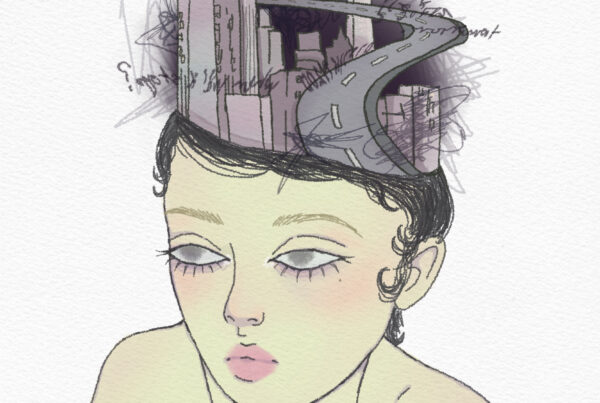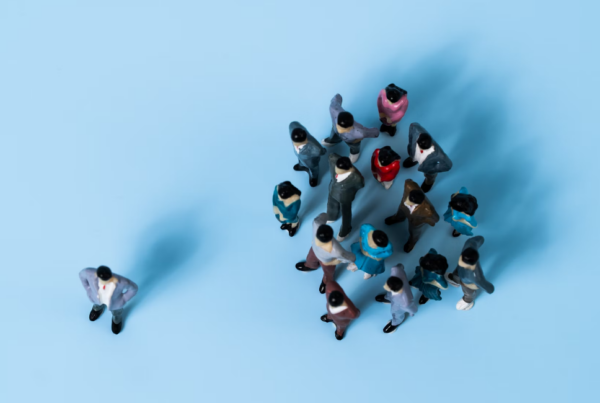
i can’t separate myself from my desire to be pretty, it appears to be something so intrinsic about me in the way i can’t do anything without its presence looming over me. almost second nature and yet i’m painfully aware it isn’t part of my nature at all, as this abstract idea of beauty morphs alongside the media and trends which i try to pretend i’m not affected by.
and i will ladder up layers of makeup and spend hours carefully crafting my image after what i have been told i should be, while telling myself i enjoy this labour i make myself endure.
and while everyone is praying with their eyes closed i still unconsciously pucker my lips so the god who i don’t believe in can see me as prettier than what he made me.
i can’t separate myself from my desire to be pretty, it appears to be something so intrinsic about me in the way i can’t do anything without its presence looming over me. almost second nature and yet i’m painfully aware it isn’t part of my nature at all, as this abstract idea of beauty morphs alongside the media and trends which i try to pretend i’m not affected by.
and i will ladder up layers of makeup and spend hours carefully crafting my image after what i have been told i should be, while telling myself i enjoy this labour i make myself endure.
and while everyone is praying with their eyes closed i still unconsciously pucker my lips so the god who i don’t believe in can see me as prettier than what he made me.

Photo by Михаил Секацкий on Unsplash

Photo by Михаил Секацкий on Unsplash
I wrote this passage at the age of 18, a time at which this pursuit of the transient beauty ideal occupied my thoughts more often than I would like to admit. Over time I have started to make peace with the body that I now feel less hesitant to call my own. Becoming more aware of how the media I consume affects the beauty standards I, at one point, devoted my life to was an essential part of this process. I hope this essay is as enlightening to you as these past two years have been to my relationship with existing as a corporeal being.
We cannot escape media in our daily lives, it is everywhere around us, and we are even often propelled to seek it out of our own volition. Yet, the ways in which it affects us are often deeply pervasive. It tells us what to think, who to be, and what to look like. Advertising, for example, creates personal needs, which in turn can change our attitudes, personal preferences, and most importantly self-image (Chyong-Ling & Jin-Tsann, 2009). This change is often adverse to one’s view of oneself, as exemplified by research demonstrating that media portrayals of conventionally attractive women had a detrimental effect on female viewers’ satisfaction with their own appearance (Grabe et al., 2008). This negative effect is not limited to women, however. As the media’s portrayal of the beauty ideal has become increasingly more dominant and general, it has started affecting men to a greater degree (Widdows, 2018). Such beauty standards depicted by the media are omnipresent in our lives, and the ways in which we try to conform to them can almost be seen as devotional. By giving us an ideal of the prototype human, the media capitalizes upon our insecurities, as the driver of our related negative affect – the discrepancy between who we ought to be and who we are now (Higgins, 1987) – can be supposedly remedied with superfluous products and procedures disguised as self improvement tools.
Not surprisingly, the popularity of cosmetic procedures has been steadily increasing over the past few decades (American Academy of Facial Plastic and Reconstructive Surgery, 2020). The desire to undergo such procedures can be linked to online exposure to images of women who are believed to have undergone cosmetic procedures themselves (Di Gesto et al., 2021). Beauty standards are raised with the proliferation of such content, which depicts the nearly unattainable picture of perfect beauty, brought to life only under the knife. The never-ending quest to live up to such standards drives profits for companies that benefit from you feeling bad about your appearance. Your lack of satisfaction with your body becomes a means through which markets can be expanded.
“Beauty standards are raised with the proliferation of such content, which depicts the nearly unattainable picture of perfect beauty, brought to life only under the knife.”
The way people are driven to buy “quick fixes” for their appearance can be described through cultivation theory, which posits that greater exposure to the media’s ideal beauty leads to less recognition that such beauty standards are unrealistic (Gerbner et al. 1994). Subsequently, ways to achieve such divine perfection, even if extreme in nature, may be normalized (Veldhuis et al., 2020). Conformity to beauty standards becomes an expectation, both for ourselves and for others, as illustrated by research showing that media exposure to such standards predicted disordered eating in women, as well as men’s attitudes in favor of women dieting (Harrison & Cantor, 1997). Through this, living up to beauty standards starts feeling like a personal responsibility, and failing to do so demarks the failure of oneself (Widdows, 2018). Beauty becomes an ethical value, which guides our perception of others and of ourselves as either “good” or “bad”.
However, over time this ideal beauty transforms into something else entirely, with body shapes becoming fleeting trends as they go in and out of style (Anderson et al., 2022). Thus, the pursuit of this beauty ideal never ceases, as just when one is close to achieving what they think is perfection, the media morphs beauty standards into something else entirely. Through this, our self-image becomes fragile, as our “ought self” is broken down and revived anew with each passing trend, making it difficult for us to form a coherent self-image over time. Professor Widdows, from the University of Birmingham, argues that we have increasingly come to locate the “self” in our body – both in the actual body and in the imagined one that is ever changing with the transient beauty standards – causing us to further embrace beauty standards. Any remaining sense of self-identity becomes subjugated by the media’s portrayal of this ideal human, whereby we increasingly come to perceive ourselves in relation to what we are told we should be, which essentially leads us to see ourselves more negatively as the beauty standard is unattainable by design.
“the pursuit of this beauty ideal never ceases, as just when one is close to achieving what they think is perfection, the media morphs beauty standards into something else entirely. ”
That said, it is possible to become more aware of how the media affects our self-image, and to denounce its beauty standards is to regain control over who we want to be, not who we are told we should be. Results from a meta-analysis suggest that social comparisons are automatic processes. This is shown as the effect sizes of the idealized beauty portrayals on appearance satisfaction are smallest when participants focused on appearance dimensions (which requires conscious processing) and largest when participants focused on other dimensions (Want, 2009). This implies that the effects of media’s idealized portrayals can be circumvented through conscious processing, potentially making it easier to not internalize such beauty standards. The aversive effects of social comparison can also be minimized by questioning their relevance or fairness (Stapel & Schwinghammer, 2004), which can be accomplished by, for example, questioning the value of physical attractiveness to one’s life. Being critically aware of what messages you consume enables you to notice what you are being sold. And to form an identity outside of the media’s portrayal of who you ought to be might be a more effective means of being able to sustain your self-image despite the transient trends.
While the media imposes a version of the idealized perfect human we should supposedly try to be (as a means to sell us a quick fix to our insecurities), it is possible to construct a more positive self-image. To make peace with the body you were born in is an arduous journey if you are constantly reminded that your innocuous traits are something that need to be “fixed”, and to accept yourself not despite your apparent “flaws” but because of them is the first step in the right direction. <<
References
– Anderson, J. B., Laughter, M., Hatch, J., Patel, P., Maymone, M. B., & Vashi, N. A. (2022). Shifting the standard of beauty: beginning of the body inclusive model. Cureus. https://doi.org/10.7759/cureus.25584
– Di Gesto, C., Nerini, A., Policardo, G.R. et al. Predictors of Acceptance of Cosmetic Surgery: Instagram Images-Based Activities, Appearance Comparison and Body Dissatisfaction Among Women. Aesth Plast Surg 46, 502–512 (2022). https://doi.org/10.1007/s00266-021-02546-3
– Gerbner, G., Gross, L., Morgan, M., & Signorielli, N. (1994). Growing up with television: The cultivation perspective.
– Grabe, S., Ward, L. M., & Hyde, J. S. (2008). The role of the media in body image concerns among women: A meta-analysis of experimental and correlational studies. Psychological Bulletin, 134(3), 460–476. https://doi.org/10.1037/0033-2909.134.3.460
– Harrison, K., & Cantor, J. (1997). The relationship between media consumption and eating disorders. Journal of Communication, 47(1), 40–67. https://doi.org/10.1111/j.1460-2466.1997.tb02692.x
– Higgins, E. T. (1987). Self-discrepancy: A theory relating self and affect. Psychological Review, 94(3), 319–340. https://doi.org/10.1037/0033-295x.94.3.319
– Lin, C.-L., & Yeh, J.-T. (2009). Comparing Society’s Awareness of Women: Media-Portrayed Idealized Images and Physical Attractiveness. Journal of Business Ethics, 90(1), 61–79. http://www.jstor.org/stable/27735225
– Stapel, D. A., & Schwinghammer, S. A. (2004). Defensive social comparisons and the constraints of reality. Social Cognition, 22, 147–167.
– Veldhuis, J., Alleva, J. M., De Vaate, N. a. B., Keijer, M. G., & Konijn, E. A. (2020). Me, my selfie, and I: The relations between selfie behaviors, body image, self-objectification, and self-esteem in young women. Psychology of Popular Media, 9(1), 3–13. https://doi.org/10.1037/ppm0000206
– Want, S. C. (2009). Meta-analytic moderators of experimental exposure to media portrayals of women on female appearance satisfaction: Social comparisons as automatic processes. Body Image, 6(4), 257–269. https://doi.org/10.1016/j.bodyim.2009.07.008
– Widdows, H. (2018). Perfect me. https://doi.org/10.23943/9781400889624
I wrote this passage at the age of 18, a time at which this pursuit of the transient beauty ideal occupied my thoughts more often than I would like to admit. Over time I have started to make peace with the body that I now feel less hesitant to call my own. Becoming more aware of how the media I consume affects the beauty standards I, at one point, devoted my life to was an essential part of this process. I hope this essay is as enlightening to you as these past two years have been to my relationship with existing as a corporeal being.
We cannot escape media in our daily lives, it is everywhere around us, and we are even often propelled to seek it out of our own volition. Yet, the ways in which it affects us are often deeply pervasive. It tells us what to think, who to be, and what to look like. Advertising, for example, creates personal needs, which in turn can change our attitudes, personal preferences, and most importantly self-image (Chyong-Ling & Jin-Tsann, 2009). This change is often adverse to one’s view of oneself, as exemplified by research demonstrating that media portrayals of conventionally attractive women had a detrimental effect on female viewers’ satisfaction with their own appearance (Grabe et al., 2008). This negative effect is not limited to women, however. As the media’s portrayal of the beauty ideal has become increasingly more dominant and general, it has started affecting men to a greater degree (Widdows, 2018). Such beauty standards depicted by the media are omnipresent in our lives, and the ways in which we try to conform to them can almost be seen as devotional. By giving us an ideal of the prototype human, the media capitalizes upon our insecurities, as the driver of our related negative affect – the discrepancy between who we ought to be and who we are now (Higgins, 1987) – can be supposedly remedied with superfluous products and procedures disguised as self improvement tools.
Not surprisingly, the popularity of cosmetic procedures has been steadily increasing over the past few decades (American Academy of Facial Plastic and Reconstructive Surgery, 2020). The desire to undergo such procedures can be linked to online exposure to images of women who are believed to have undergone cosmetic procedures themselves (Di Gesto et al., 2021). Beauty standards are raised with the proliferation of such content, which depicts the nearly unattainable picture of perfect beauty, brought to life only under the knife. The never-ending quest to live up to such standards drives profits for companies that benefit from you feeling bad about your appearance. Your lack of satisfaction with your body becomes a means through which markets can be expanded.
“Beauty standards are raised with the proliferation of such content, which depicts the nearly unattainable picture of perfect beauty, brought to life only under the knife.”
The way people are driven to buy “quick fixes” for their appearance can be described through cultivation theory, which posits that greater exposure to the media’s ideal beauty leads to less recognition that such beauty standards are unrealistic (Gerbner et al. 1994). Subsequently, ways to achieve such divine perfection, even if extreme in nature, may be normalized (Veldhuis et al., 2020). Conformity to beauty standards becomes an expectation, both for ourselves and for others, as illustrated by research showing that media exposure to such standards predicted disordered eating in women, as well as men’s attitudes in favor of women dieting (Harrison & Cantor, 1997). Through this, living up to beauty standards starts feeling like a personal responsibility, and failing to do so demarks the failure of oneself (Widdows, 2018). Beauty becomes an ethical value, which guides our perception of others and of ourselves as either “good” or “bad”.
However, over time this ideal beauty transforms into something else entirely, with body shapes becoming fleeting trends as they go in and out of style (Anderson et al., 2022). Thus, the pursuit of this beauty ideal never ceases, as just when one is close to achieving what they think is perfection, the media morphs beauty standards into something else entirely. Through this, our self-image becomes fragile, as our “ought self” is broken down and revived anew with each passing trend, making it difficult for us to form a coherent self-image over time. Professor Widdows, from the University of Birmingham, argues that we have increasingly come to locate the “self” in our body – both in the actual body and in the imagined one that is ever changing with the transient beauty standards – causing us to further embrace beauty standards. Any remaining sense of self-identity becomes subjugated by the media’s portrayal of this ideal human, whereby we increasingly come to perceive ourselves in relation to what we are told we should be, which essentially leads us to see ourselves more negatively as the beauty standard is unattainable by design.
“the pursuit of this beauty ideal never ceases, as just when one is close to achieving what they think is perfection, the media morphs beauty standards into something else entirely. ”
That said, it is possible to become more aware of how the media affects our self-image, and to denounce its beauty standards is to regain control over who we want to be, not who we are told we should be. Results from a meta-analysis suggest that social comparisons are automatic processes. This is shown as the effect sizes of the idealized beauty portrayals on appearance satisfaction are smallest when participants focused on appearance dimensions (which requires conscious processing) and largest when participants focused on other dimensions (Want, 2009). This implies that the effects of media’s idealized portrayals can be circumvented through conscious processing, potentially making it easier to not internalize such beauty standards. The aversive effects of social comparison can also be minimized by questioning their relevance or fairness (Stapel & Schwinghammer, 2004), which can be accomplished by, for example, questioning the value of physical attractiveness to one’s life. Being critically aware of what messages you consume enables you to notice what you are being sold. And to form an identity outside of the media’s portrayal of who you ought to be might be a more effective means of being able to sustain your self-image despite the transient trends.
While the media imposes a version of the idealized perfect human we should supposedly try to be (as a means to sell us a quick fix to our insecurities), it is possible to construct a more positive self-image. To make peace with the body you were born in is an arduous journey if you are constantly reminded that your innocuous traits are something that need to be “fixed”, and to accept yourself not despite your apparent “flaws” but because of them is the first step in the right direction. <<



